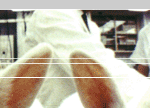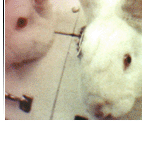Click here to go back.
WHO IS EXPERIMENTED ON?
Many species of animals fall victim to such a miserable life in a product testing laboratory: rabbits, guinea pigs, rats and mice in particular.
Rabbits are routinely used because they are docile and thus easy to manipulate.1 Mice are exploited even more often since they are inexpensive and easy to handle. The federal Animal Welfare Act (AWA) is meant to secure the basic rights of animals in laboratories, such as access to food and water. But many animals, such as reptiles, birds, rats and mice are intentionally excluded.2 These animals are given absolutely no legal protection from neglect and abuse.
Product-testing laboratories also commonly buy animals from breeders. For animals born at these facilities, their entire lives--from birth to death--will be spent in barren metal cages. They will never have the chance to feel the grass beneath their feet or the sun on their backs.
The animal testing industry also obtains animals from shelters. This is called “pound seizure” and is promoted by many vivisection advocates. These animals, usually dogs and cats, are either lost or have been abandoned. There is no federal law regulating pound seizure. Thirteen states have banned this practice. Three states, Minnesota, Oklahoma, and Utah actually legally require their shelters to provide animals to vivisection laboratories.3,4,5
Animals are also bought from individuals known as Class B dealers. These dealers buy animals for the purpose of selling them to laboratories. Class B dealers acquire animals from random sources, such as answering “Free to Good Home” ads, picking up strays and operating animal auctions, in which they arrange and negotiate animal sales and transport. Class B dealers have also be caught stealing pet dogs from peoples' yards to sell to laboratories.6,7
1. Ron Banks, "Rabbits: Models and Research Applications," United States Army Medical Research Institute of Infectious Diseases (October 1989).
2. Animal Welfare Act, Title 7, Chapter 54, section 2132(g).
3. Minnesota Agriculture, Chapter 35, Animal Health, Minn. Stat. § 35.71 (2001) Unclaimed & Unredeemed Animals Impounded; Scientific Use or Other Disposition, subd.3.
4. Oklahoma Title 4, Animals, Chapter 13, Use of Unclaimed Animals for Scientific Investigation and Education. 4 Okl. St. § 394 (2002).
5. Utah Title 26, Utah Health Code, Chapter 26, Experimental Animals, Utah Code Ann. § 26-26 3&4 (2002)
6. Animal Welfare Institute, "The Case Against Random Source Dogs and Cats," (August 1996).
7. The American Psychological Society, "Animal Research In Jeopardy," (September 2005).







